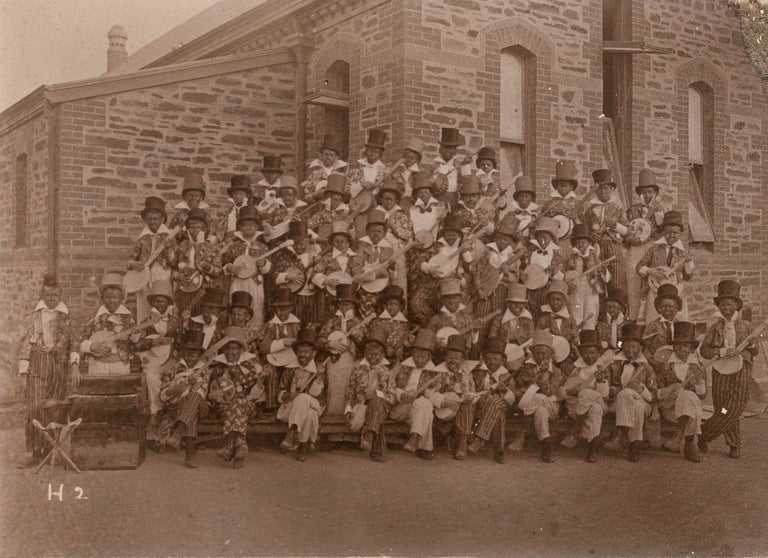
A group photograph of young lads in blackface, dressed as minstrels with banjos
[Hindmarsh, Unknown Photographer, circa September 1898].
An original gelatin silver photograph (image size 151 × 209 mm, with the small reference number H2 in the negative), mounted on thick card as issued (247 × 304 mm).
Small amount of matching watercolour applied to the top right-hand corner of the image when it was printed (to mask a slight imperfection in the negative); minor surface loss to silverfish to the mount, with slight loss to the corners; the photograph itself is in excellent condition, and all blemishes to the mount can be completely matted out.
'The banjo was introduced to America by enslaved Africans in the mid-1600s.... the earliest banjos, also known as banjars, were not the instruments we recognize today. Early banjos varied greatly. They could have any number of strings. The body could be made from a gourd or other hollowed frame. The shared feature was an animal skin stretched across the body which gave the instrument its signature tone as the strings were plucked or strummed. Those early banjos remained exclusive to the black culture for 200 years ... When white culture embraced the banjo kind of as their own in the mid-1800s, it came at the expense of the black culture, with white performers performing in blackface doing grossly exaggerated performances that really ridiculed the black culture' (Johnny Baier, executive director of the American Banjo Museum, quoted in 'From Slavery To Minstrelsy, The Banjo's Troubled History', an interview with Jim Johnson, online). We have identified the place, date and subjects in this extraordinary image: the 53 boys (there are possibly two adults seated in the second-bottom row) are students at Hindmarsh Public School in suburban Adelaide, in full dress as per their performance at the first concert of the city and suburban Model Schools at the Exhibition Hall on Thursday 15 September 1898. The lengthy account of the event appeared in the 'South Australian Register' the next day: with the benefit of hindsight, and in light of the above observations, it makes sombre reading. 'The chief contributors to the mirth of the evening were the Hindmarsh boys, who, attired in amusing caricatures of the fantastic garments usually affected by the burnt-cork profession, kept the audience in a continual state of merriment while they occupied the platform. Indeed, these youngsters afforded quite a study of the various shapes and shades of the tall hat, as well as the many methods of wearing these, together with costumes that were certainly remarkable for colour, coat-tails that were too long, collars that were too large, and faces of all degrees of blackness, proving irresistibly mirth-provoking. Of all the band perhaps the efforts of the leader, who manipulated a dummy organ with great earnestness and vigour after the fashion of certain minstrels often seen in our streets, were the most comic. Two songs - "Da old banjo" and "Goodnight" - were contributed by the queer company, but their vocal efforts were entirely outshone by the comic effect of their attire and actions'.
Item #120634
Price (AUD):
$1,100.00
